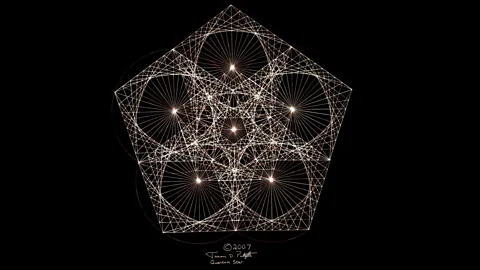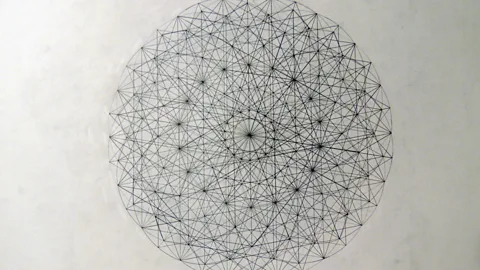The violent attack that turned a man into a maths genius
 Getty
GettyFuton salesman Jason Padgett cared little about anything beyond partying and chasing girls, then one fateful night changed him forever.
This article was inspired by an episode of The Outlook Podcast, where you can hear more about Jason Padgett's experience in his own words.
Jason Padgett sees maths everywhere. Even something as ordinary as brushing his teeth is governed by mathematics – he turns the tap on and dips his toothbrush into the water 16 times.
“I don’t know why I like perfect squares,” he says. “It’s not just a perfect square, it’s two to the power of four or four squared but I just like perfect squares… I automatically do that stuff with everything.”
Padgett is so obsessed with maths and understands such complex concepts, he's been called a genius. He certainly has a rare talent for drawing repeating geometric patterns – known as fractals – by hand.
You might also like:
• Is it right to use Nazi science?
But the former futon salesman from Alaska hasn’t always had a way with numbers. Just under 17 years ago he was living a very different life in Tacoma, Washington.
“I was very shallow,” he laughs. “Life rotated around girls, partying, drinking, waking up with a hangover and then going out and chasing girls and going out to bars again.”
Maths wasn’t on his radar whatsoever.
“I used to say ‘math is stupid, how can you use that in the real world’? And I thought that was like a smart statement. I really believed it.”
But on the night of Friday 13 September 2002 everything changed. (Read more about why some people become sudden geniuses).
While out with friends, Padgett was attacked and robbed by two men outside a karaoke bar. They took his already torn leather jacket.
 Jason Padgett
Jason Padgett“I heard as much as felt this deep, low-pitched thud as the first guy ran up behind me and smashed me in the back of the head,” he recalls. “And I saw this puff of white light just like someone took a picture. The next thing I knew I was on my knees and everything was spinning and I didn’t know where I was or how I got there.”
Padgett staggered to a hospital across the street where he was told he had concussion and a bleeding kidney thanks to a punch to the gut. “They gave me a shot of pain medication and sent me home,” he remembers.
But once home, Padgett’s behaviour changed quickly and dramatically. He had sustained a traumatic brain injury, which can bring on obsessive compulsive disorder - OCD. In Jason's case, he became increasingly afraid of the outside world and would only leave his house to stock up on food.
“I just remember nailing blankets and towels over all the windows in the house… I remember actually using this spray foam and gluing the front door shut.”
The OCD had made Padgett irrationally afraid of germs, which had a knock-on effect on his daughter who would come to stay with him amidst custody negotiations with his ex-partner.
“When she would come over I would obsessively wash my hands and clean,” he says. “The very first thing I would want to do is get her shoes off, get her into clean clothes, wash her hands.”
But while Padgett was experiencing all these negative consequences from his attack, something incredible was happening too. The way Jason was seeing things changed.
 Getty
Getty“Everything that was curved looked like it was slightly pixelated,” he explains. “Water coming down the drain didn’t look like it was a smooth, flowing thing anymore, it looked like these little tangent lines.”
The same thing happened with clouds, sunlight streaming between trees and puddles. To Padgett, the world essentially looked like a retro video game. Seeing such a radically different view of his surroundings evoked conflicting emotions in Padgett. “I was surprised…confused. It was beautiful but it was also scary at the same time.”
Because of these visions, Padgett began to think about huge questions in relation to mathematics and physics. Given his hermit-like existence at that time, the internet became a valuable source of information to him as he read extensively about mathematics online.
He stumbled across a webpage about fractals which struck a chord with him. It’s a difficult mathematical concept which, put at its most basic, can be likened to a snowflake. When you zoom in, you will see it’s made up of smaller snowflakes connected together, zoom in again and those snowflakes are made of smaller snowflakes, and so on until infinity.
Padgett was fascinated by this concept but didn’t yet have the words to describe it until one day his daughter asked him how the TV worked.
 Jason Padgett
Jason Padgett“When you’re looking at a TV screen and you see a circle it’s really not a circle,” he says. “It’s made with rectangles or squares and, if you look close, the edge of the circle is really a zig zag. You can take those pixels and cut them in half and cut them in half and you get closer and closer to a perfect circle but you never actually reach one because you can keep cutting the pixels in half forever, so the resolution gets better but you never have a perfect circle.”
Padgett felt compelled to explore this intriguing concept further. So, he began to draw. And he kept drawing.
“I had literally a thousand or more drawings of circles, fractals, every shape that I could manage to draw. It was the only way I could manage to communicate effectively what I was seeing.”
Padgett believed his drawings “held the key to the universe” and were so important that he needed to take them everywhere with him.
While on a rare trip out one day, he was approached by a man who had noticed Padgett with his drawings and told him they looked mathematical.
 Jason Padgett
Jason Padgett“I’m trying to describe the discrete structure of space time based on Planck length (a tiny unit of measurement developed by physicist Max Planck) and quantum black holes,” Padgett told him. It turned out the man was a physicist and recognised the high-level mathematics Padgett was drawing. He urged him to take a maths class, which led Padgett to enrol in a community college, where he began to learn the language he needed to describe his obsession.
After three and a half years of living like a virtual hermit, going to school changed everything for Padgett. He started to get psychological help for his OCD and even met the woman who would become his wife.
But why was he seeing things in such a strange and different way? Why was his world now comprised of geometric shapes and graphs?
Poetically, it was television that again provided him with a clue. Padgett saw a man, a so-called savant, who had extraordinary numerical abilities and talked about what numbers looked like to him.
 Jason Padgett
Jason Padgett“I would always describe that math was shapes not numbers and that was the first time I’d heard anybody but me talk about what numbers looked like,” says Padgett.
He scoured the internet for more information and came across Berit Brogaard, a cognitive neuroscientist now at the University of Miami. The pair spent hours talking on the phone and from these conversations, Brogaard hypothesised that Padgett had synaesthesia – essentially a cross-wiring of the brain in which the senses get mixed up. (Find out more about synaesthesia — and whether it can be learnt).
It is estimated to effect only around 4% of the population. Some synesthetes might see certain colours when they hear music or smell something that’s not there when feeling a particular emotion.
The condition is caused by connections between parts of the brain that are not there in other people. You can be born this way or some type of trauma, an injury, a stroke, an allergic reaction, can change the brain.
Brogaard believes the brain injury Padgett sustained caused him to develop a form of synaesthesia where certain things triggered visions of mathematical formulas or geometric shapes, either in his mind or projected in front of him. She also hypothesised that synaesthesia made Padgett an acquired savant.
“Most of us don’t have that kind of insight because we don’t visualise mathematical formulas,” says Brogaard.
 Alamy
AlamyTo test these ideas, Brogaard brought Padgett to the Brain Research Unit of Aalto University in Helsinki, where he underwent a series of brain scans.
While in the MRI scanner, hundreds of equations, including fake ones, flashed on a screen in front of Padgett’s eyes. The researchers then watched which parts of his brain lit up in response.
“They found that I had access to parts of the brain that we don’t have conscious access to and also the visual cortex was working in conjunction with the part of the brain that does mathematics, which obviously makes sense,” says Padgett.
Brogaard’s hypotheses turned out to be true. Padgett was formally diagnosed with acquired savant syndrome and a form of synaesthesia. Finally, he had answers.
Since his diagnosis, Padgett has published a book about his experience called Struck by Genius, he’s toured the world telling people his story and educating them about maths. He is aiming to help others who have had unique or rare/interesting lives by getting their stories published or made into movies. He even sells his drawings of fractals.
The two men who attacked him that fateful September night were never convicted despite Padgett identifying them and pressing charges.
 Jason Padgett
Jason PadgettYears later, however, one of the men, Brady Simmons, wrote to Padgett to apologise while he was undergoing treatment for prescription drug addiction following a suicide attempt. In a sense, two lives were changed in the years that followed the attack.
“I’m a completely different person,” says Simmons. “When I look back the abysmal person that I was in the past, I just don’t see how I existed on that level.”
Padgett too feels like he is a different person than he was before.
“I see it [beauty] everywhere,” he says. He is mesmerised by simple things that most people don’t even notice such as raindrops falling on a puddle.
Through Padgett’s eyes, the puddle is transformed into complex rippling patterns, overlapping and forming shapes like stars or snowflakes. And he wants everyone else to see what he sees.
“You should be walking around in absolute amazement at all times that reality even exists,” he says. “I’m having this mathematical awakening and all around us is absolute magic or about as close as you can get to magic.”
--
If you liked this story, sign up for the weekly bbc.com features newsletter, called “The Essential List”. A handpicked selection of stories from BBC Future, Culture, Worklife, and Travel, delivered to your inbox every Friday.
